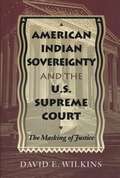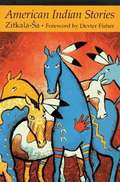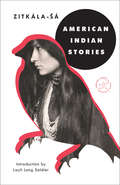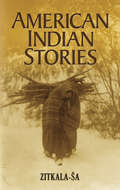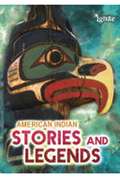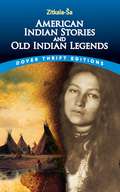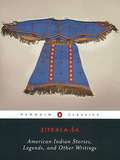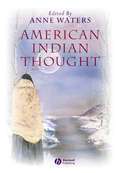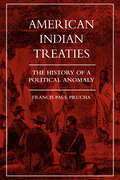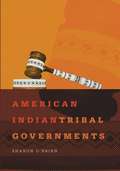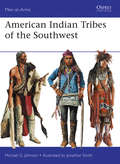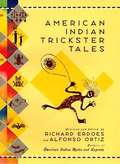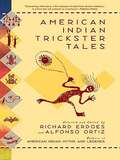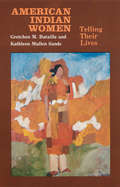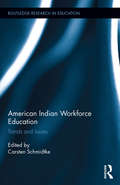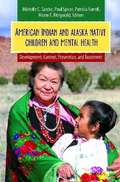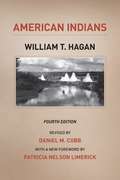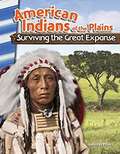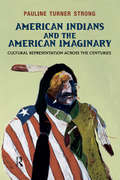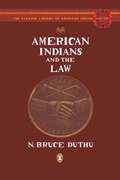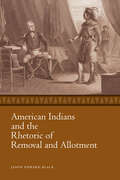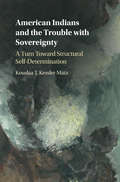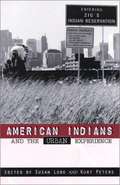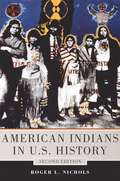- Table View
- List View
American Indian Sovereignty and the U.S. Supreme Court: The Masking of Justice
by David E. Wilkins"Like the miner's canary, the Indian marks the shift from fresh air to poison gas in our political atmosphere; and our treatment of Indians, even more than our treatment of other minorities, reflects the rise and fall in our democratic faith," wrote Felix S. Cohen, an early expert in Indian legal affairs. In this book, David Wilkins charts the "fall in our democratic faith" through fifteen landmark cases in which the Supreme Court significantly curtailed Indian rights. He offers compelling evidence that Supreme Court justices selectively used precedents and facts, both historical and contemporary, to arrive at decisions that have undermined tribal sovereignty, legitimated massive tribal land losses, sanctioned the diminishment of Indian religious rights, and curtailed other rights as well. These case studies-and their implications for all minority groups-make important and troubling reading at a time when the Supreme Court is at the vortex of political and moral developments that are redefining the nature of American government, transforming the relationship between the legal and political branches, and altering the very meaning of federalism.
American Indian Stories
by Zitkala-saAutobiography of Zitkala-Sa (aka Gertrude Bonnin), a Dakota Sioux Indian, and tales she heard from the oral tradition of her tribe. First published in 1921.
American Indian Stories (Modern Library Torchbearers)
by Zitkala-SaA groundbreaking Dakota author and activist chronicles her refusal to assimilate into nineteenth-century white society and her mission to preserve her culture—with an introduction by Layli Long Soldier, winner of the National Book Critics Circle Award and the PEN/Jean Stein Book Award for Whereas Bright and carefree, Zitkála-Šá grows up on the Yankton Sioux reservation in South Dakota with her mother until Quaker missionaries arrive, offering the reservation’s children a free education. The catch: They must leave their parents behind and travel to Indiana. Curious about the world beyond the reservation, Zitkála-Šá begs her mother to let her go—and her mother, aware of the advantages that an education offers, reluctantly agrees. But the missionary school is not the adventure that Zitkála-Šá expected: The school is a strict one, her long hair is cut short, and only English is spoken. She encounters racism and ridicule. Slowly, Zitkála-Šá adapts to her environment—excelling at her studies, winning prizes for essay-writing and oration. But the price of success is estrangement from her cultural roots—and is it one she is willing to pay? Combining Zitkála-Šá’s childhood memories, her short stories, and her poetry, American Indian Stories is the origin story of an activist in the making, a remarkable woman whose extraordinary career deserves wider recognition.The Modern Library Torchbearers series features women who wrote on their own terms, with boldness, creativity, and a spirit of resistance.
American Indian Stories (Native American)
by Zitkala-SaBorn on South Dakota's Yankton Reservation in 1876, Zitkala-Sa felt "as free as the wind that blew my hair, and no less spirited than a bounding deer." At the age of 8, she traded her freedom for the iron discipline of a Quaker boarding school. Forever afterward, the Lakota Sioux author struggled to find a balance between Indian and white society. These autobiographical essays, short stories, and political writings offer her poignant reflections on being stranded between two worlds. Zitkala-Sa, who attended and taught at the Carlisle Indian Industrial School in Pennsylvania, was a founder of the National Council of American Indians and among the first Native Americans to record tribal legends and oral traditions. This collection opens with her reminiscences of the reservation, her schooling at an institution determined to "civilize" Indians, and her experiences as a teacher. Zitkala-Sa also recounts tales rooted in Sioux traditions, including "A Warrior's Daughter," in which a courageous woman risks everything for her husband-to-be; "The Trial Path," an account of tribal justice after a murder; and "The Sioux," in which a son must kill twice to save his father from starvation. The book concludes with incisive observations on government mistreatment of Indians and a call for the complete enfranchisement of Native Americans into mainstream society.
American Indian Stories and Legends (All About Myths)
by Catherine ChambersAmerican Indians have always told stories filled with characters, creatures, and legends that have fascinated people around the world. This book mixes dramatic retellings and nonfiction information to give a full picture of American Indian stories, exploring the gods, goddesses, heroes, villains, tricksters, and quests that make American Indian stories and legends so compelling.
American Indian Stories and Old Indian Legends (Dover Thrift Editions)
by Zitkala-sa"Whether your interest in Sioux folklore is great or small, you will find this a fascinating book to devour. Pick up a copy today and be thrilled." -- The Reading RoomThis accessible and affordable volume combines two essential collections by Sioux author Zitkala-Sa. American Indian Stories assembles short stories, autobiographical reflections, and political essays that offer poignant reflections on the author's sense of being stranded between the white and Native American worlds. Old Indian Legends features tales from the oral tradition -- legends passed down through the generations that form a genre known as the "retold tale." Born on South Dakota's Yankton Reservation in 1876, Zitkala-Sa felt "as free as the wind that blew my hair, and no less spirited than a bounding deer." At the age of eight, she traded her freedom for the iron discipline of a Quaker boarding school. Disillusioned by American society as well as her own tribe, Zitkala-Sa attended college, became a teacher, and wrote about her experiences in a variety of books and magazines. A prominent advocate for Native American rights throughout her life, she was a key figure in the legislation that granted Native Americans citizenship in 1924.
American Indian Stories, Legends, and Other Writings
by Zitkala-saZitkala-Sa wrestled with the conflicting influences of American Indian and white culture throughout her life. Raised on a Sioux reservation, she was educated at boarding schools that enforced assimilation and was witness to major events in white-Indian relations in the late 1800s and early 1900s. Tapping her troubled personal history, Zitkala-Sa created stories that illuminate the tragedy and complexity of the American Indian experience. In evocative prose laced with political savvy, she forces new thinking about the perceptions, assumptions, and customs of both Sioux and white cultures and raises issues of assimilation, identity, and race relations that remain compelling today. .
American Indian Thought: Philosophical Essays
by Anne WatersThis book brings together a diverse group of American Indian thinkers to discuss traditional and contemporary philosophies and philosophical issues.
American Indian Treaties: The History of a Political Anomaly
by Francis Paul PruchaAmerican Indian affairs are much in the public mind today—hotly contested debates over such issues as Indian fishing rights, land claims, and reservation gambling hold our attention. While the unique legal status of American Indians rests on the historical treaty relationship between Indian tribes and the federal government, until now there has been no comprehensive history of these treaties and their role in American life.Francis Paul Prucha, a leading authority on the history of American Indian affairs, argues that the treaties were a political anomaly from the very beginning. The term "treaty" implies a contract between sovereign independent nations, yet Indians were always in a position of inequality and dependence as negotiators, a fact that complicates their current attempts to regain their rights and tribal sovereignty.Prucha's impeccably researched book, based on a close analysis of every treaty, makes possible a thorough understanding of a legal dilemma whose legacy is so palpably felt today.
American Indian Tribal Governments
by Sharon O'BrienThis book describes the struggle of Indian tribes and their governments to achieve freedom and self-determination despite repeated attempts by foreign governments to dominate, exterminate, or assimilate them. Drawing on the disciplines of political science, history, law, and anthropology and written in a direct, readable style, American Indian Tribal Governments is a comprehensive introduction to traditional tribal governments, to the history of Indian-white relations, to the structure and legal rights of modern tribal governments, and to the changing roles of federal and state governments in relation to modem tribal governments. Publication of this book fills a gap in American Indian studies, providing scholars with a basis from which to begin an integrated study of tribal government, providing teachers with an excellent introductory textbook, and providing general readers with an accessible and complete introduction to American Indian history and government. The book's unique structure allows coverage of a great breadth of information while avoiding the common mistake of generalizing about all tribes and cultures. An introductory section presents the basic themes of the book and describes the traditional governments of five tribes chosen for their geographic and cultural diversity-the Senecas, the Muscogees, the Lakotas, the Isleta Pueblo, and the Yakimas. The next three chapters review the history of Indian-white relations from the time Christopher Columbus "discovered" America to the present. Then the history and modem government of each of the five tribes presented earlier is examined in detail. The final chapters analyze the evolution and current legal powers of tribal governments, the tribal-federal relationship, and the tribal-state relationship. American Indian Tribal Governments illuminates issues of tribal sovereignty and shows how tribes are protecting and expanding their control of tribal membership, legal systems, child welfare, land and resource use, hunting and fishing, business regulation, education, and social services. Other examples show tribes negotiating with state and federal governments to alleviate sources of conflict, including issues of criminal and civil jurisdiction, taxation, hunting and fishing rights, and control of natural resources. Excerpts from historical and modem documents and speeches highlight the text, and more than one hundred photos, maps, and charts show tribal life, government, and interaction with white society as it was and is. Included as well are a glossary and a chronology of important events.
American Indian Tribes of the Southwest
by Michael Johnson Jonathan SmithThis book continues Osprey's series of Men-at-Arms titles on the history, costume, and material culture of the native peoples of North America, which is organized into geographical regions, language groups, and tribes. It was in the Southwest - modern Arizona, New Mexico, and parts of California and other neighboring states - that the first major clashes took place between 16th-century Spanish conquistadors and the indigenous peoples of North America. This uniquely long history of contact, conflict, and coexistence with first the Spanish, then their Mexican settlers, and finally the Americans, gives a special flavor to the region. So too does the wide cultural diversity of the peoples who inhabited the challenging environment of the Southwest - from the quasi-Plains culture of the Kiowa-Apache and Lipan, to the pueblo cave-villages of the agricultural Zuni and Hopi. (Indeed, from c. 1700 to 1848 the Pueblo villagers often allied themselves with Spanish and Mexican settlers against the encroachments of Apache and Navajo hunters and raiders.) Despite nearly 500 years of white settlement and pressure, the traditional cultures of the peoples of the Southwest survive today more strongly than in any other region, and with them a sense of separate identity. The best-known clashes between the whites and the Indians of this region are the series of Apache wars, particularly between the early 1860s and the late 1880s. However, there were other important regional campaigns over the centuries - for example, Coronado's battle against the Zuni at Hawikuh in 1540, during his search for the legendary "Seven Cities of Cibola"; the Pueblo Revolt of 1680; and the Taos Revolt of 1847 - and warriors of all of these are described and illustrated in this book. War was inseparable in the local cultures from religious beliefs, such as the veneration of the mothers of war gods - White Painted Woman among the Apache, and Changing Woman among the Navajo; the plates in this book illustrate the rites associated with such figures, and several other important ritual observances. The variety of costumes illustrated, from the earliest times up to today, make these plates especially rich.
American Indian Trickster Tales
by Richard Erdoes Alfonso Ortizit's the Trickster who provides the real spark in the action
American Indian Trickster Tales
by Richard ErdoesOf all the characters in myths and legends told around the world, it's the wily trickster who provides the real spark in the action, causing trouble wherever he goes. This figure shows up time and again in Native American folklore, where he takes many forms, from the irascible Coyote of the Southwest, to Iktomi, the amorphous spider man of the Lakota tribe. This dazzling collection of American Indian trickster tales, compiled by an eminent anthropologist and a master storyteller, serves as the perfect companion to their previous masterwork, American Indian Myths and Legends. American Indian Trickster Tales includes more than one hundred stories from sixty tribes? many recorded from living storytellers?which are illustrated with lively and evocative drawings. These entertaining tales can be read aloud and enjoyed by readers of any age, and will entrance folklorists, anthropologists, lovers of Native American literature, and fans of both Joseph Campbell and the Brothers Grimm. .
American Indian Women: Telling Their Lives
by Gretchen M. Bataille Kathleen Mullen SandsIndian women's autobiographies have been slighted because of the assumption that women had a secondary and insignificant role in Indian society. Gretchen M. Bataille and Kathleen Mullen Sands cogently demonstrate in this book the creative vitality of autobiographies that, despite differences in style and purpose, clarify the centrality of women in American Indian cultures. Included is a comprehensive, annotated bibliography or works by and about American Indian women.
American Indian Workforce Education: Trends and Issues (Routledge Research in Education #163)
by Carsten SchmidtkeIn this collection of original essays, contributors critically examine the pedagogical, administrative, financial, economic, and cultural contexts of American Indian vocational education and workforce development, identifying trends and issues for future research in the fields of vocational education, workforce development, and American Indian studies.
American Indian and Alaska Native Children and Mental Health: Development, Context, Prevention, and Treatment
by Paul Spicer Michelle C. Sarche Patricia Farrell Hiram E. FitzgeraldThis book examines the physical, psychological, social, and environmental factors that support or undermine healthy development in American Indian children, including economics, biology, and public policies.
American Indians
by William T. HaganWilliam Hagan’s classic American Indians has become standard reading in the field of Native American history. Daniel M. Cobb has taken over the task of updating and revising the material, allowing the book to respond to the times. Spanning the arrival of white settlers in the Americas through the twentieth century, this concise account includes more than twenty new maps and illustrations, as well as a bibliographic essay that surveys the most recent research in Indian-white relations. With an introduction by Cobb, and a foreword by eminent historian Patricia Nelson Limerick, this fourth edition marks the fiftieth anniversary of the original publication of American Indians.
American Indians Of The Plains: Surviving The Great Expanse (Social Studies: Informational Text Series)
by Jennifer Overend PriorHighlight some of the fascinating aspects of life on the Plains with the American Indians of the Plains: Surviving the Great Expanse e-Book. Students will explore different facets of Plains culture, including the importance of buffalo in everyday life – as their source of food, clothing, homes, weapons, and many other things. This informational text takes a look at some of the distinctive features of the Lakota, Cheyenne, Comanche, Pawnee, Osage, Omaha, and Crow tribes. Ignite a curiosity with this nonfiction reader that breathes life into the pages of history with real-life artifacts from that era. Build literacy and subject content knowledge with this rigorous, high-interest reader that explores US history, geography, and other social studies topics. The American Indians of the Plains: Surviving the Great Expanse e-Book provides access to every type of learner with appropriately leveled content. The e-Book contains text features such as captions, bold print, glossary, and index to increase understanding and build academic vocabulary. Aligned to McREL, WIDA/TESOL, NCSS/C3 Framework and other state standards, this text readies students for college and career readiness.
American Indians and the American Dream: Policies, Place, and Property in Minnesota
by Kasey R. KeelerUnderstanding the processes and policies of urbanization and suburbanization in American Indian communities Nearly seven out of ten American Indians live in urban areas, yet studies of urban Indian experiences remain scant. Studies of suburban Natives are even more rare. Today&’s suburban Natives, the fastest-growing American Indian demographic, highlight the tensions within federal policies working in tandem to move and house differing groups of people in very different residential locations. In American Indians and the American Dream, Kasey R. Keeler examines the long history of urbanization and suburbanization of Indian communities in Minnesota.At the intersection of federal Indian policy and federal housing policy, American Indians and the American Dream analyzes the dispossession of Indian land, property rights, and patterns of home ownership through programs and policies that sought to move communities away from their traditional homelands to reservations and, later, to urban and suburban areas. Keeler begins this analysis with the Homestead Act of 1862, then shifts to the Indian Reorganization Act in the early twentieth century, the creation of Little Earth in Minneapolis, and Indian homeownership during the housing bubble of the early 2000s.American Indians and the American Dream investigates the ways American Indians accessed homeownership, working with and against federal policy, underscoring American Indian peoples&’ unequal and exclusionary access to the way of life known as the American dream. Cover alt text: Vintage photo of Native person bathing smiling child in the sink of a midcentury kitchen. Title in yellow.
American Indians and the American Imaginary: Cultural Representation Across the Centuries
by Pauline Turner StrongAmerican Indians and the American Imaginary considers the power of representations of Native Americans in American public culture. The book's wide-ranging case studies move from colonial captivity narratives to modern film, from the camp fire to the sports arena, from legal and scholarly texts to tribally-controlled museums and cultural centres. The author's ethnographic approach to what she calls "representational practices" focus on the emergence, use, and transformation of representations in the course of social life. Central themes include identity and otherness, indigenous cultural politics, and cultural memory, property, performance, citizenship and transformation. American Indians and the American Imaginary will interest general readers as well as scholars and students in anthropology, history, literature, education, cultural studies, gender studies, American Studies, and Native American and Indigenous Studies. It is essential reading for those interested in the processes through which national, tribal, and indigenous identities have been imagined, contested, and refigured.
American Indians and the Law
by N. Bruce DuthuA perfect introduction to a vital subject very few Americans understand-the constitutional status of American Indians Few American s know that Indian tribes have a legal status unique among America's distinct racial and ethnic groups: they are sovereign governments who engage in relations with Congress. This peculiar arrangement has led to frequent legal and political disputes-indeed, the history of American Indians and American law has been one of clashing values and sometimes uneasy compromise. In this clear-sighted account, American Indian scholar N. Bruce Duthu explains the landmark cases in Indian law of the past two centuries. Exploring subjects as diverse as jurisdictional authority, control of environmental resources, and the regulations that allow the operation of gambling casinos, American Indians and the Law gives us an accessible entry point into a vital facet of Indian history. .
American Indians and the Rhetoric of Removal and Allotment (Race, Rhetoric, and Media Series)
by Jason Edward BlackJason Edward Black examines the ways the US government’s rhetoric and American Indian responses contributed to the policies of Native–US relations throughout the nineteenth century’s removal and allotment eras. Black shows how these discourses together constructed the perception of the US government and of American Indian communities. Such interactions—though certainly not equal—illustrated the hybrid nature of Native–US rhetoric in the nineteenth century. Both governmental, colonizing discourse and indigenous, decolonizing discourse shaped arguments, constructions of identity, and rhetoric in the colonial relationship.American Indians and the Rhetoric of Removal and Allotment demonstrates how American Indians decolonized dominant rhetoric through impeding removal and allotment policies. By turning around the US government’s narrative and inventing their own tactics, American Indian communities helped restyle their own identities as well as the government’s. During the first third of the twentieth century, American Indians lobbied for the successful passage of the Indian Citizenship Act of 1924 and the Indian New Deal of 1934, changing the relationship once again.In the end, Native communities were granted increased rhetorical power through decolonization, though the US government retained an undeniable colonial influence through its territorial management of Natives. The Indian Citizenship Act and the Indian New Deal—as the conclusion of this book indicates—are emblematic of the prevalence of the duality of US citizenship that fused American Indians to the nation yet segregated them on reservations. This duality of inclusion and exclusion grew incrementally and persists now, as a lasting effect of nineteenth-century Native–US rhetorical relations.
American Indians and the Trouble with Sovereignty: A Turn Toward Structural Self-Determination
by Kessler-Mata Kouslaa T.With tribes and individual Indians increasingly participating in American electoral politics, this study examines the ways in which tribes work together with state and local governments to overcome significant governance challenges. Much scholarship on tribal governance continues to rely on a concept of tribal sovereignty that does not allow for or help structure this type of governance activity. The resulting tension which emerges in both theory and practice from American Indian intergovernmental affairs is illuminated here and the limits of existing theory are confronted. Kessler-Mata presents an argument for tribal sovereignty to be normatively understood and pragmatically pursued through efforts aimed at interdependence, not autonomy. By turning toward theories of federalism and freedom in the republican tradition, the author provides an alternative framework for thinking about the goals and aspirations of tribal self-determination.
American Indians and the Urban Experience
by Susan Lobo Kurt PetersThis is a collection of essays describing the Native Americans' experiences beyond the reservation.
American Indians in U.S. History (Second Edition)
by Roger L. NicholsThe author traces tribal experiences through four eras: Indian America prior to the European invasions; the colonial period; the emergence of the United States as the dominant power in North America and its subsequent invasion of Indian lands; and the years from 1900 to the present. Nichols uses both Euro-American sources and tribal stories to illuminate the problems Indian people and their leaders have dealt with in every generation.
